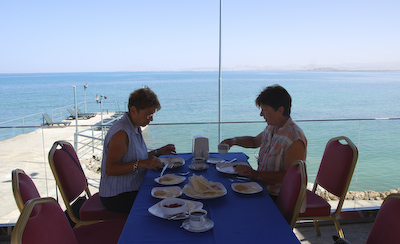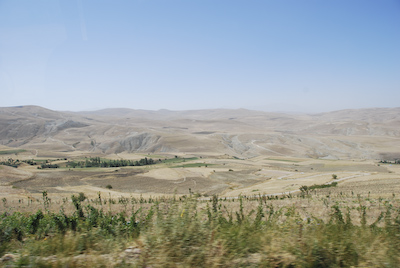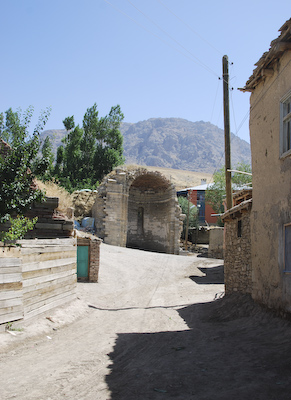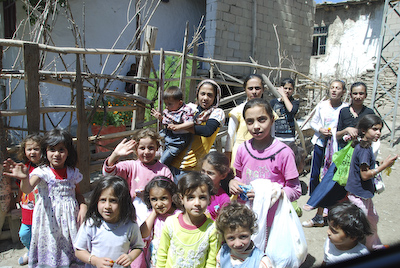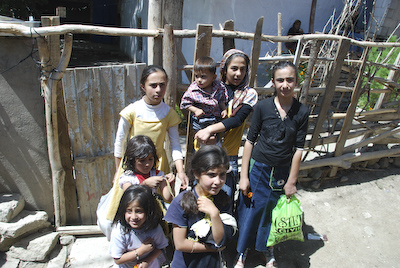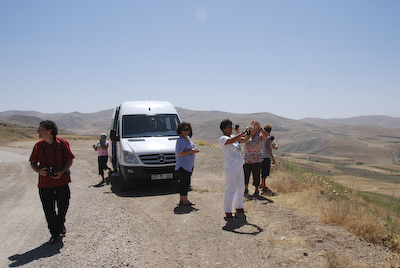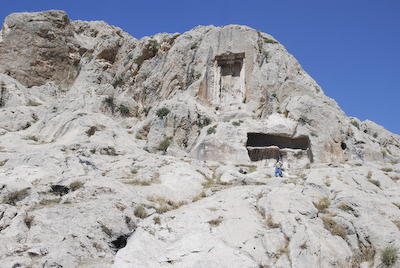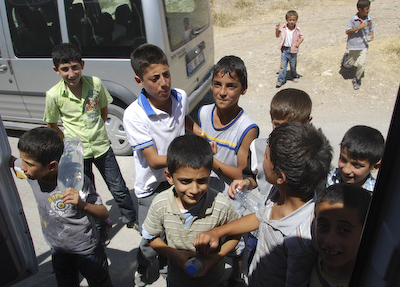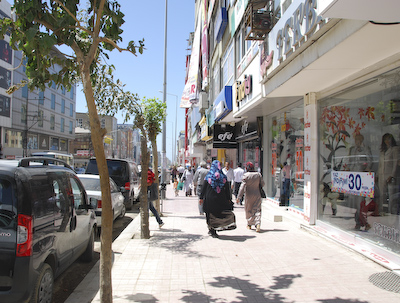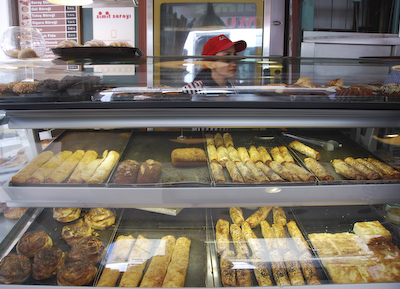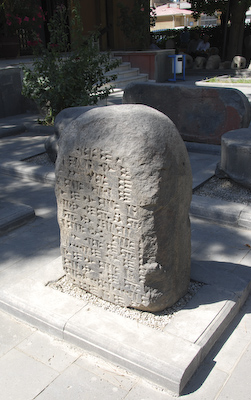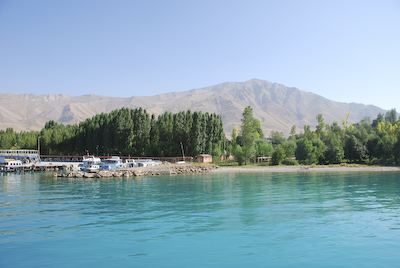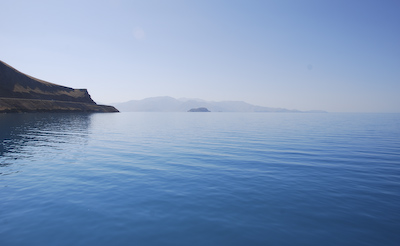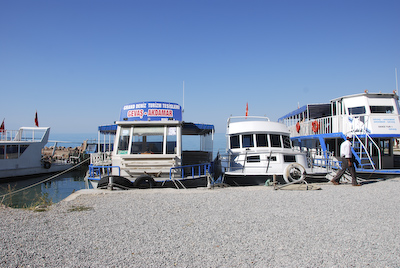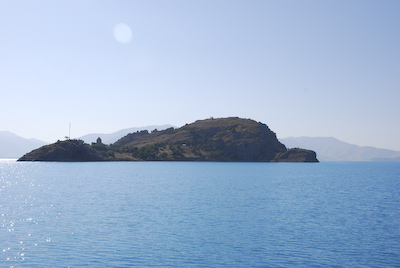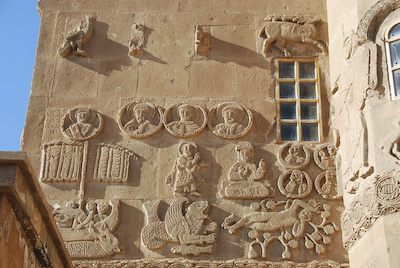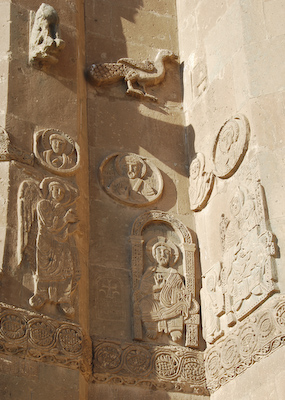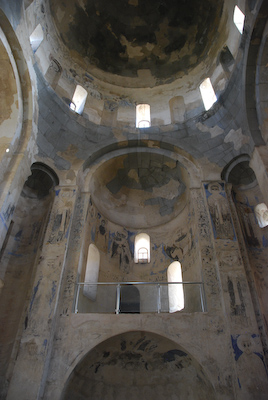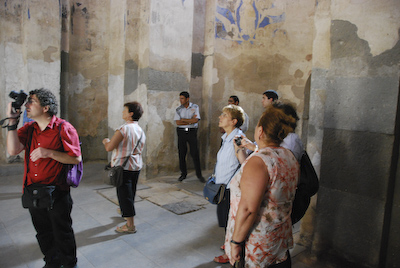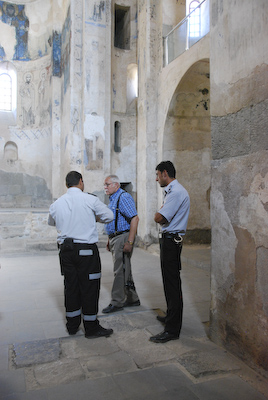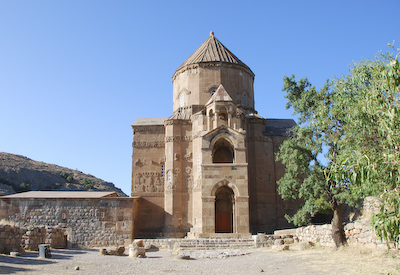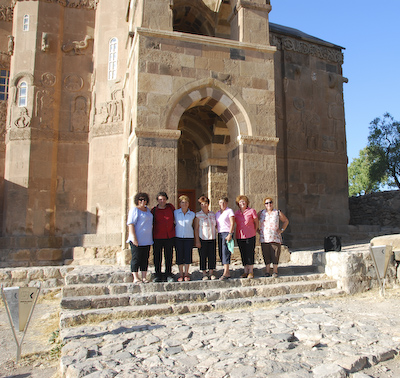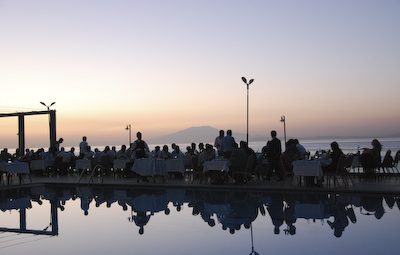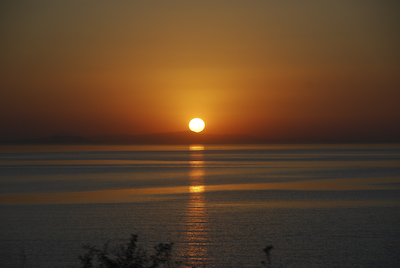August 19th Thursday
Breakfast the next morning was on the patio of the hotel along Lake Van. I had difficulty sleeping last night because there was no air conditioning and the room was very hot. I tried to open the window but the noise from the nearby road kept waking me up as cars whizzed by until the early hours of the morning.
It was a warm brilliant morning and the sunlight reflected brightly on the lake. I was tired but energized by the idea of being in Van. I’m pretty sure that my grandparents had never visited the famous lake, although they probably knew about it. They never mentioned it in conversations with me when I was young. Also, transportation from Sebastia to Van would have been very difficult for them a hundred years ago.
The sun was shining brightly in a cloudless blue sky. The heat was already starting to grow. I met everyone by the pool and we had coffee and chai with a surprisingly large assortment of breakfast offerings.
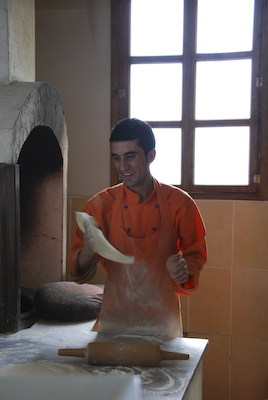 Fresh Baked Bread in the Morning
Fresh Baked Bread in the Morning
The kingdom of Urartu, the biblical Ararat, flourished near the Van Rock, from the 13th through the 7th centuries BC. The Urartians borrowed much of their culture, including cuneiform writing, from the neighboring Assyrians with whom they were usually battling. The Assyrians never subdued the Urartians, but joined with several other tribes to cause the downfall the the Urartian kingdom. By the 6th century BC the region was settled by the Armenians, who are believed to be the descendants of the Urartians. After the fall of the Byzantines in 1071, Turkish emirs ruled the region until the Ottomans took over in 1468. The Ottomans destroyed the old city of Van before Russian occupation in 1915. The new current city of Van was built 4km east of the old site.
The Countryside of Van
After breakfast, we all gathered and boarded the vans for a tour of the Van region. The city is located right on the lake with dry brown grassy hills rising behind it to the east. Our first destination was an old Armenian church which was located in a Kurdish village. The villagers maintain the care and upkeep of the church by charging a small donation fee.
In A Kurdish Village
We drove into the Kurdish village and immediately the children circled the van. The women peeked out from their doors and windows, men began to gather with curiosity, and the children happily greeted the strangers.
A House in the Village
In this village the children came prepared with lovely beaded head-scarves, which they claimed they had made by hand. The children were charming and it was hard to move beyond them to the church. In the other villages, it was usually the boys who gathered to talk to us. In this village, the girls greeted us.
Kurdish Girls
The door of the church was small and encircled with Armenian writing. Inside the long abandoned church, it was cool and dark, dimly lit by a couple of incandescent light bulbs. The dome was gone and covered with wood. The caretaker and his family had arranged wooden slats to display scarves and other trinkets to sell to visitors.
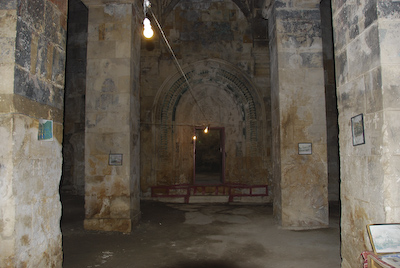 Interior of the Former Armenian Church
Interior of the Former Armenian Church
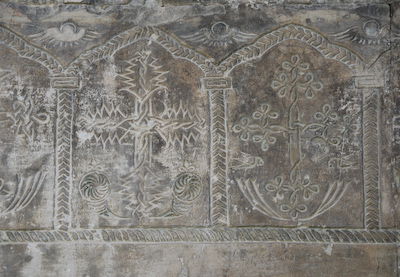 Close-up of Stone Ornamentation Inside the Church
Close-up of Stone Ornamentation Inside the Church
The city of Van is a fairly large city with a population of almost 400,000 people. According to the guides, the majority of the people who live in Van are Kurdish.
Taking Photographs on the Road
After we left the village, we stopped along the road to take photos of Van in the distance. Then we stopped at a place where we could see the tombs of some Urartan kings close-up. As the story goes, one of the kings comes out of his tomb on a special day every year to see if there is world-wide peace. If there is no peace, he returns to his cave for another year. When there is peace, he will leave his cave and join the people.
Urartu Tombs
This time young boys scrambled down from the high rocks like mountain goats to greet our vans. They were really cute, jostling for a close position and calling out “Hellos” in English!! None of these children are begging for money. They are curious about us and want some recognition and ask to have their photos taken. Then they laugh when we show them their image on the back of the camera.
Young Boys Greeting Our Van
Van was bustling with people and cars and looked like any other busy Turkish city with shops, food stores, department stores, pharmacies, etc. The Lonely Planet Guidebook gives these encouraging words: “Van is different in spirit from the rest of southeastern Anatolia – more urban, more casual, less rigorous…” It was a relief for us after the warnings about Erzurum.
Modern Street in the City of Van
We stopped at a busy intersection and got out of the vans to go into a jewelery store to look at silver pieces. We all got out of the vans and went into the store. The silver jewelery was beautiful and unique. They were made in the Armenian silver jeweler’s technique using Urartu designs and symbols. The pieces were so unique that I had to buy something. So I bought a necklace and earings. We took a long time to look at the beautiful jewelery. Chris explored the neighborhood and found another good bakery. We also bought some yummy baked goodies at the corner bakery to eat for a casual lunch on the road.
Then we went to the Archeological Museum. As we entered, we met some Armenian people from Canada. They were also cousins and two were from Montreal, who spoke French, and the other two were from Toronto and spoke English. We compared travel ideas and notes and they said to make sure to sing the Lord’s Prayer in Akdamar Church. They also told us not to pay attention to the guards who might complain about our singing.
Archeology Museum
The museum was very interesting. It had a good collection of Urartan artifacts and explanations of where they come from and how they lived thousands of years ago. There were also several Khatch Kars (“cross stones” literally) in good condition with Armenian lettering and Urartu cuneiform inscriptions. These were used as grave markers for important people in ancient times.
Ancient Cuneiform Writing
I was very happy that we had a chance to visit the museum. Then we returned to the Merit Hotel, picked up the Zeronians and went to the shore of Lake Van to go to Akdamar Island. There is virtually no water sports on the lake and no resorts. There are natural sand beaches, but very few people venture into the beautiful turquoise water.
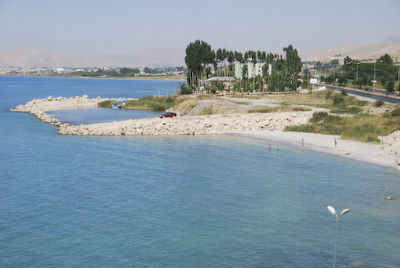 View from My Window at the Merit Hotel
View from My Window at the Merit Hotel
Lake Van is the largest lake in Turkey and the second largest in the Middle East. The lake water is alkaline and is rich in sodium carbonate and other salts. It was formed by a volcanic explosion of Mt. Nemrud, whose last eruption was in 1440 AD. It is more that 74 miles across at its widest point and has an average depth of 561 feet according to the guidebook.
The water is not suitable for drinking or irrigation because of its high salinity and only a very limited species of fish can live there. The lake is surrounded by fruit and grain-growing agricultural areas. The lake was the center of the Armenian Kingdom of Ararat from about 1000 BC. Along with Lake Sevan in today’s Armenia and Lake Urmia in today’s Iran, Van was one the three great lakes of the Armenian Kingdom, referred to as the “Sea of Armenia” in ancient times.
We drove a few miles down the shore of the lake to a place where ferries wait to take people to Akdamar Island. Armen bought tickets for all of us and we boarded the boat.
Akdamar Island is the second largest of four islands in Lake Van. It is home to the 10th century Armenian Church of the Holy Cross (Armenian: Սուրբ Խաչ, Surp Khach), which served as a royal church to the Armenian Vaspurakan Kingdom and was the seat of the Armenian Catholicos from 1116 to 1895. The ruins of Armenian monasteries also exist on the other three islands of Lake Van: Lim, Arter, and Ktuts.
The origin and meaning of the island’s name is unknown, but is often attributed to an old Armenian legend. According to the story, an Armenian princess named Tamar lived on the island and was in love with a commoner. The youth would swim from the mainland to the island each night, guided by a lantern she lit for him. Her father learned of the boy’s visits. One night, as she waited for her lover to arrive, her father smashed the lantern leaving the boy in the middle of the lake without a guide to indicate which direction to swim. They say his dying cries of “Akh, Tamar…” (“Oh, Tamar”) can be heard to this day at night. The legend was the inspiration for a famous Armenian poem by Hovhannes Tumanyan.
We were the only passengers on that particular trip. The sun shone brilliantly in the flat calm water. The breeze of the moving boat felt wonderful on my face as the boat chugged along to Akdamar Island in the distance. The young Turkish captain of the boat had lively turkish music playing quietly in his cabin and we asked him to raise the volume. We danced and swayed to the music in exuberance as the boat sailed closer to the island. It was a joy to watch the island grow larger as we approached it.
We could just see the top of the famous steeple of the Church of the Holy Cross on the other side of the island from the boat dock. We got off the boat and walked up the steep stone path and around to the church. On September 19th there will be the first church service in this church with Armenian priests officiating since 1915. It will be a grand event. I wish I could be there to see it!
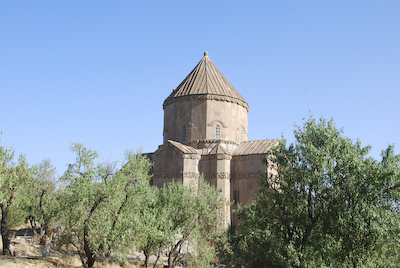 Armenian Church of the Holy Cross
Armenian Church of the Holy Cross
The outside of the church is in remarkable condition. The ornamentation stone reliefs around the church are in excellent condition due to recent reconstruction efforts. They are magnificent!
Each one depicts a story from the bible and they continue around the outside of the church building. We climbed up the high stone steps and went inside. Efforts have been made recently to restore the paintings and one can see the beauty and brilliant colors of the original works of art.
There were two Turkish guards walking around the church. They weren’t threatening; they were just smoking and entertaining each other with conversation. We admired the exterior and interior of the church and we noticed that it had wonderful acoustics right under the main dome in the middle.
Interior of the Church
We then called everyone together, and we all stood right under the dome and we started to sing the Lord’s Prayer (Hymer) in Armenian. All 18 of us started to sing – what a sound!!! – but then the guards yelled at us to stop. We continued for a few minutes, but they shouted at us and we had to stop singing.
Armen stepped in and began to talk to the guard who seemed to be in charge. Armen talked to him in Turkish for a long time. A few of us milled around and finally, Armen said that we had permission to sing!
Armen and the Turkish Guards
We quickly gathered everyone again and started to sing the Hymer in Armenian under the church dome as loud as we could, facing up to the heavens in honor of our grandparents and parents and all the other Armenians who could not sing or pray in their home churches or country any more. It was a really strong emotional experience and I had difficulty continuing to the end. Filled with tears and sorrow, we thought about our grandparents and parents and the sacrifices they made and how difficult their lives had been as survivors. We remembered their parents who were lost in the genocide. WOW!! What an experience…….
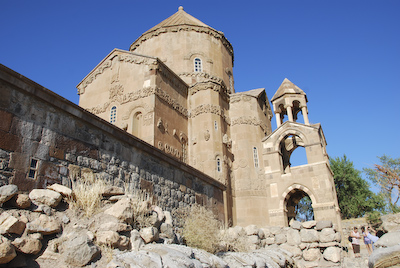 Exterior of the Church of the Holy Cross
Exterior of the Church of the Holy Cross
Later, I asked Armen what he had said to the guard to get him to change his mind. He said that he told the guard that we were 20 people and when we went home we would each tell another 10 people that the Turks would not let us sing in the church. Then those 200 people would tell another 10 people each, that the Turks would not allow singing in the church. And those 2000 people would tell another 10 people each and quickly hundreds of thousands of people would know that the guards at Akdamar do not allow singing and it would bring disgrace to the government. Armen also said that he told the guard that people would be singing on September 21st during the service, so if the Turkish government allows singing next month, of course they will allow it today!
We all thanked the guards for allowing us to sing in Akdamar Kilisesi, the Turkish name for the Church of the Holy Cross, and smiled appreciatively at them. They looked relieved that they were saved from an international and major incident.
We explored the exterior of the church and the grounds around the church and then happily walked back to the boat. It had been quite an experience and quite a day….
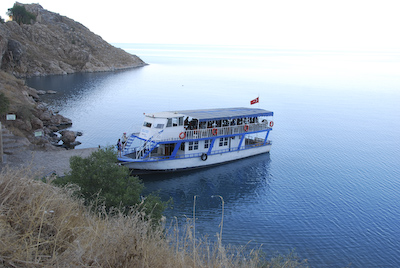 Our Ferry Back to the Mainland
Our Ferry Back to the Mainland
We returned to the Merit Hotel to relax before dinner. The weather was hot and dry and everyone needed a refreshing shower.
Dinner between the Lake and the Pool
There was a cool breeze blowing off the lake near the pool in the evening and we ate a good relaxing dinner. Afterwards we all gathered in the lobby to talk and laugh and share our experiences. It was actually too cool to sit outside!
